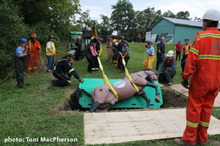âA successful emergency rescue is about 90 percent preparation and 10% action,â reiterated Ontario SPCA officer Bonnie Bishop. Bishop canât say enough about how the Technical Large Animal Emergency Rescue program, presented by Equine Guelph last fall, has helped her on the job.

Emergency workers role play rescuing a horse
Ontario SPCA officer Bonnie Bishop canât say enough about how the Technical Large Animal Emergency Rescue program, presented by Equine Guelph last fall, has helped her on the job including when a bull was trapped down a well.
© 2015 by Tony MacPherson
On March 17, 2015 preparation was put into action when a bull trapped down a well, just north of Napanee, was successfully rescued with Bonnie helping triage the situation on the end of a phone line with agent Tex Ridder on the scene.
"Many organizations that participate in TLAER programs do not realize how far reaching this program is - that it concerns situations from loose horses on the highway, to cattle truck rollovers, to animals trapped and needing professional extrication.
The most important feature of the program is safety for the people on the scene first," says Dr. Rebecca Gimenez of Technical Large Animal Emergency Rescue Inc.
Bishop was over two hours away in Cornwall when the call about a trapped Charolais bull came in. Although adrenaline kicked in right from the start â the TLAER program armed her with a logical system for assessing the dilemma.
Realizing the bull was not in immediate danger she knew lowering down some hay and water were first on the list to keep the bull calm while more calls could be made.;
Knowing the Incident Command System is one of the most valuable components when pulling together resources for a rescue. From first responders to the forklift operator and veterinarian, Bishop recounted how knowing the simple practical steps involved in making a plan and following a chain of command throughout execution is.
Staying calm through the whole situation, the bullâs owner then contacted all the necessary resources.
Both the in-class videos and hands on demonstrations from the TLAER program came into play. The memorable videos on âwhat not to doâ coupled with the practical hands-on work detailing how to safely arrange recovery straps to a large animal contributed to a successful vertical lift.
Bishop remembered from one of the class videos how important a chest strap was to stop a large animal from slipping out during a forklift rescue. While they were not able to secure a chest strap, the rescuers on the scene improvised to ensure the bull would not tip forward during lifting.They placed the bull down a good distance away from the chasm ensuring he would not stumble back in after his airborne adventures.
The rescue can be viewed on YouTube at:
http://www.youtube.com/watch?v=TLc7QHBFhA0&sns=em
Teamwork and planning are key ingredients to successful emergency rescues. The next 2-day Technical Large Animal Emergency Rescue awareness hands-on seminar will be offered Oct 3 â 4 at Grand River Raceway in Elora, Ontario.
It is appropriate for a very broad audience - horse owners, first responders, law enforcement, animal control officers, veterinarians, veterinary technicians, emergency animal response teams, livestock producers and associations.
This program is applicable to obtain continuing education credits for coaches (from Equine Canada) and for veterinarians, veterinary technicians and emergency responders (from their respective organizations).
Registration is limited and there is an early bird special $179 until July 15, 2015.
Support provided by Grand River Agricultural Society and Ontario Ministry of Agriculture, Food and Rural Affairs.
For more information about this program feel free to contact Susan Raymond slraymon@uoguelph.ca and also see article: Awareness Training for Large Animal Rescue â Always Expect the Unexpected for an overview of the first TLAER operations level program hosted in Ontario by Equine Guelph.
About Equine Guelph
Equine Guelph is the horse ownersâ and care giversâ Centre at the University of Guelph. It is a unique partnership dedicated to the health and well-being of horses, supported and overseen by equine industry groups. Equine Guelph is the epicentre for academia, industry and government â for the good of the equine industry as a whole. For further information, visit www.EquineGuelph.ca.
Story by Jackie Bellamy-Zions
